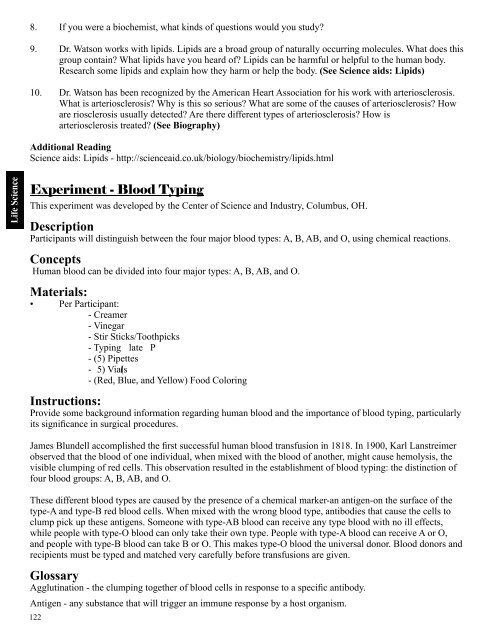ScienceMakers Toolkit Manual - The History Makers
ScienceMakers Toolkit Manual - The History Makers
ScienceMakers Toolkit Manual - The History Makers
You also want an ePaper? Increase the reach of your titles
YUMPU automatically turns print PDFs into web optimized ePapers that Google loves.
Life Science<br />
8. If you were a biochemist, what kinds of questions would you study?<br />
9. Dr. Watson works with lipids. Lipids are a broad group of naturally occurring molecules. What does this<br />
group contain? What lipids have you heard of? Lipids can be harmful or helpful to the human body.<br />
Research some lipids and explain how they harm or help the body. (See Science aids: Lipids)<br />
10. Dr. Watson has been recognized by the American Heart Association for his work with arteriosclerosis.<br />
What is arteriosclerosis? Why is this so serious? What are some of the causes of arteriosclerosis? How<br />
are riosclerosis usually detected? Are there different types of arteriosclerosis? How is<br />
arteriosclerosis treated? (See Biography)<br />
Additional Reading<br />
Science aids: Lipids - http://scienceaid.co.uk/biology/biochemistry/lipids.html<br />
Experiment - Blood Typing<br />
This experiment was developed by the Center of Science and Industry, Columbus, OH.<br />
Description<br />
Participants will distinguish between the four major blood types: A, B, AB, and O, using chemical reactions.<br />
Concepts<br />
Human blood can be divided into four major types: A, B, AB, and O.<br />
Materials:<br />
• Per Participant:<br />
- Creamer<br />
- Vinegar<br />
- Stir Sticks/Toothpicks<br />
- Typing late P<br />
- (5) Pipettes<br />
- 5) Vials (<br />
- (Red, Blue, and Yellow) Food Coloring<br />
Instructions:<br />
Provide some background information regarding human blood and the importance of blood typing, particularly<br />
its signifi cance in surgical procedures.<br />
James Blundell accomplished the fi rst successful human blood transfusion in 1818. In 1900, Karl Lanstreimer<br />
observed that the blood of one individual, when mixed with the blood of another, might cause hemolysis, the<br />
visible clumping of red cells. This observation resulted in the establishment of blood typing: the distinction of<br />
four blood groups: A, B, AB, and O.<br />
<strong>The</strong>se different blood types are caused by the presence of a chemical marker-an antigen-on the surface of the<br />
type-A and type-B red blood cells. When mixed with the wrong blood type, antibodies that cause the cells to<br />
clump pick up these antigens. Someone with type-AB blood can receive any type blood with no ill effects,<br />
while people with type-O blood can only take their own type. People with type-A blood can receive A or O,<br />
and people with type-B blood can take B or O. This makes type-O blood the universal donor. Blood donors and<br />
recipients must be typed and matched very carefully before transfusions are given.<br />
Glossary<br />
Agglutination - the clumping together of blood cells in response to a specifi c antibody.<br />
Antigen - any substance that will trigger an immune response by a host organism.<br />
122










